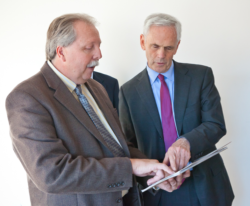
|
|
|
Contact: Marty Ralph
|
|
Secretary of Commerce Bryson Briefed on PSL's Role in Water Cycle Science
September 12, 2011
Newly appointed Secretary of Commerce, John Bryson, was briefed on the Hydrometeorolgy Testbed (HMT) and NOAA's growing efforts in water resources research and services, including technology innovation and transfer fostered by HMT and the NOAA Earth System Research Laboratory's Physical Sciences Laboratory (PSL).
During his visit to NOAA-Boulder on 7 November 2011, Secretary Bryson was informed about PSL's role in water-cycle science, including HMT and the National Integrated Drought Information System (NIDIS) as a link between research, operations, water managers, and the public, and the emerging awareness of the importance of atmospheric rivers in both water supply and flooding in the west. Technology innovation and transfer, as well as the role of atmospheric rivers in west coast flooding and water supply were highlighted. The Secretary noted his past role on the California Water Resources Control Board, and his familiarity with the American River in particular, which has also been a geographic focus of HMT-West. The creation of an HMT-West Legacy Observing Network through sponsorship of the California Department of Water Resources was discussed, including its role in technology innovation and transfer. Two examples of new sensors were displayed – a low-cost snow-level radar developed based on HMT results, and a new spaced antenna wind profiler under development partly for fire weather and wind energy applications and related to a Cooperative Research and Development Agreement (CRADA) between PSL and industry.

